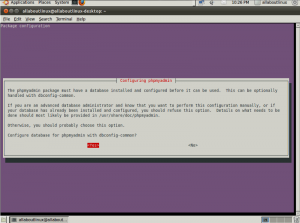

- #UNINSTALL AND REINSTALL PHPMYADMIN UBUNTU HOW TO#
- #UNINSTALL AND REINSTALL PHPMYADMIN UBUNTU INSTALL#
You can have many different site configurations available, and activate only those that you need.Īs an example, we want the default site to be /home/user/public_html/. This is what you will see when you browse to or. By default, there is one site available called 000-default. These are available in /etc/apache2/sites-available. This can all be done in a single command with the following: $ echo "ServerName localhost" | sudo tee /etc/apache2/conf.d/fqdnĪpache2 has the concept of sites, which are separate configuration files that Apache2 will read. Or $ gksu "gedit /etc/apache2/conf.d/fqdn" Use a text editor such as "sudo nano" at the command line or "gksudo gedit" on the desktop to create a new file, $ sudo nano /etc/apache2/conf.d/fqdn In older versions of Apache, the configuration files were located in a different directory. This can all be done in a single command with the following: $ echo "ServerName localhost" | sudo tee /etc/apache2/conf-available/nf & sudo a2enconf fqdn To the file, save it, and enable your new configuration file by running the command below. Or $ gksu "gedit /etc/apache2/conf-available/nf" Use a text editor such as "sudo nano" at the command line or "gksudo gedit" on the desktop to create a new file, $ sudo nano /etc/apache2/conf-available/nf With your web browser, go to the URI : if you read "It works!", which is the content of the file /var/Troubleshooting ApacheĪpache2: Could not determine the server's fully qualified domain name, using 127.0.0.1 for ServerName
#UNINSTALL AND REINSTALL PHPMYADMIN UBUNTU INSTALL#
To only install the apache2 webserver, use any method to install: You may also want to purge these packages: mysql-client-core-5.5 mysql-server-core-5.5 To get rid of any configurations you may have made to apache, manually remove the /etc/apache2 directory once the packages have been removed. To also remove the debconf data, use the purge option when removing.

You might wish to simulate this removal first, and only remove the packages that don't cause removal of something desired.Īpache2 apache2-mpm-prefork apache2-utils apache2.2-common libapache2-mod-php5 libapr1 libaprutil1 libdbd-mysql-perl libdbi-perl libnet-daemon-perl libplrpc-perl libpq5 mysql-client-5.5 mysql-common mysql-server mysql-server-5.5 php5-common php5-mysql


#UNINSTALL AND REINSTALL PHPMYADMIN UBUNTU HOW TO#
Starting over: How to remove the LAMP stack To install the default LAMP stack in Ubuntu 10.04 and above This is to help people set up and install a LAMP ( Linux- Apache- MySQL- PHP) server in Ubuntu, including Apache 2, PHP 5 and MySQL 4.1 or 5.0. Alternative: install phpMyAdmin from source.Troubleshooting Phpmyadmin & mysql-workbench.Starting over: How to remove the LAMP stack.To install the default LAMP stack in Ubuntu 10.04 and above.MYSQL_LIN: MariaDB > CREATE USER IDENTIFIED BY '' # cp /usr/local/psa/phpMyAdmin/ /usr/local/psa/phpMyAdmin/ĬONFIG_TEXT: /* User used to manipulate with storage / If after the above actions phpMyAdmin had no entries in the database or the file /usr/local/psa/phpMyAdmin/ is missing:Ĭreate the main configuration file from a sample file: Make sure the database and the user are deleted and then repeat the reinstallation. Note: If the "phpMyAdmin was configured without configuration storage in database" warning is shown during phpMyAdmin reinstallation, it means that either the phpmyadmin database or user have not been set up because they already exist in the system. # plesk db "delete from er where User=' phpmyadmin'" # plesk db dump mysql > /root/mysql`date +%F_%H.%M`.sql If it is, create a backup of the MySQL database: # plesk db "select User from er where User like '%phpmy%'" # plesk db dump phpmyadmin > /root/ phpmyadmin.sqlĬheck if the phpmyadmin user exists in the er table: Note: Databases with the names like phpmyadmin_XXXXXXXXXXXX are likely to be the customers' databases. # plesk db "show databases like '%phpmy%'" # grep controluser /usr/local/psa/phpMyAdmin/ | grep -v NOTEĬheck if the phpmyadmin database exists on the server: # grep pmadb /usr/local/psa/phpMyAdmin/ | grep -v NOTE Get the phpMyAdmin database name and MySQL username: How to reinstall phpMyAdmin in Plesk? Answer


 0 kommentar(er)
0 kommentar(er)
